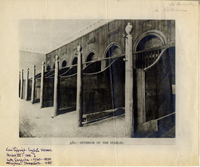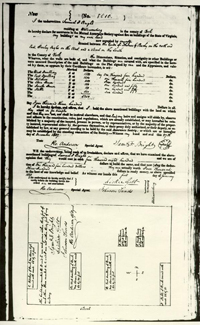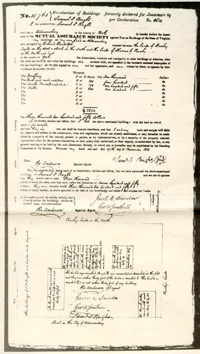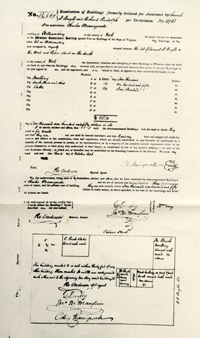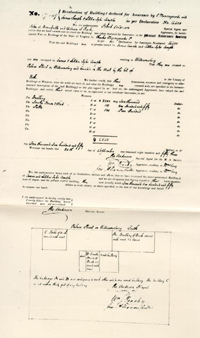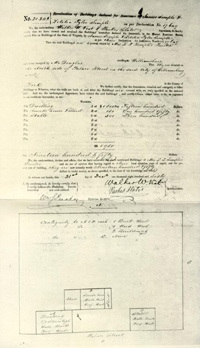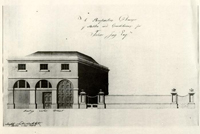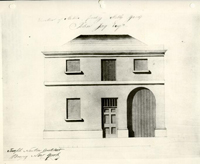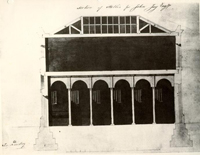Governor's Palace Stable Historical Report, Block 20 Building 4Originally entitled: "The Governor's Palace Stable (Block 20)"
Colonial Williamsburg Foundation Library Research Report Series - 1470
Colonial Williamsburg Foundation Library
Williamsburg, Virginia
1990
THE GOVERNOR'S PALACE STABLE
(Block 20)
THE GOVERNOR'S PALACE STABLE
In June, 1706, the General Assembly of Virginia passed "An act directing the building an house for the Governor of this colony and dominion," which designated land for the building, mentioned dimensions and building materials for the house proper, and appropriated £ 3000 for the purpose.1 The act directed that an overseer "take care of the same, under the direction of the governor and councill," and appointed Henry Cary overseer to "provide for the building aforesaid, with full power to begin, carry on, and finish the same, according to the directions of this act." One clause read:
"And be it further enacted, That a kitchen and stable, suitable for such an house be likewise built upon the land before mentioned, according to the discretion of the said overseer, and by the direction aforesaid."2
The lieutenant-governor, Edward Nott, died in August, 1706, shortly after the passage of this act. The next Lieutenant-governor to reach Virginia, Alexander Spotswood, did not arrive until June, 1710. Possibly that explains why work on the house and outbuildings progressed slowly. The president of the Council, Edmund Jenings, who served as acting governor during the interim, had his own plantation near Williamsburg; and there was no immediate need for the governor's house.
In April, 1708, Henry Cary, overseer of the building, notified the Council that he "had well nigh expended the whole Fund appropriated for building the said house," and asked for further directions 2 therein.1 Edmund Jenings wrote the Board of Trade in England in June, 1708 that it was "expected all the outside work" would be finished that summer, which would "exhaust the whole Fund appropriated for the building," adding that he would "take all necessary care to have that work finished as soon as may be."2 He wrote the Board again in September of that year that the whole sum was expended "and yet the rooff not rais'd, nor any inside work done"3
Soon after Alexander Spotswood arrived in Virginia, he issued writs for calling a General Assembly to meet in October, the chief business being to raise money "for finishing the Governor's house."4 The ensuing Assembly passed "An act for finishing a House for the Governor…," which appropriated £ 1560 for "finishing and compleating the said house, kitchen and stable … with all convenient expedition"; and added an additional £ 635 for "severall buildings, gardens and other ornaments" which were thought necessary for "rendering the said house more compleat and commodious." Of this latter sum, £ 250 was to be spent for "necessary standing and ornamentall furniture for the said house."5
According to Henry Cary's petition of 1709 concerning the progress of the building, he had then "almost finished ye Kitchen & Carryed up ye wall & raysed ye roffe of ye Dwelling house & Covored 3 itt with planks & layed on ye lead upon ye flatt of ye roffe".1
Apparently the stable had not been started; for a proposal for "rendering the new House Convenient as well as Ornamental," which was considered by the committee to draw up the act for finishing the Governor's house, mentioned, among other things:
"That such necessary places as Stable, Coatch house, Cowhouse & Hen-house together with an enclosed Yard for Poultry be made.These suggestions were incorporated in the act, which ordered:
That a Kitchen Garden and Orchard be paled in at leaste
That a Flower Garden behind the House as well as the Court yard before it be enclosed with a Brick wall 4 foot high with a Ballustrade of Wood on the Top.
That the Land belonging to the House being about 60 acres may be enclosed with a Ditch & Fence for a Pasture."2
"…That for a supply of money to begin, carry on and finish the aforesaid house, stable, kitchen, court-yard, garden, orchard, out-houses, and all other the work herein directed to be made and done, and also to buy the furniture aforesaid, the said overseer shall, from time to time, as occasion shall require, make application to his honour the lieut. governor… who, upon such application, is hereby desired to issue his warrant upon the…treasurer of this dominion, for so much money as may be wanted untill the full sum of fifteen hundred and sixty pounds and of six hundred thirty-five pounds shall be…expended in finishing the said house, kitchen and stable, and in making and finishing the court-yard, garden, orchard, out-houses, aforesaid…"3
The house was still unfinished in 1712, and Spotswood persuaded the Assembly to appropriate an additional £900 towards the work.4 4 This appropriation, too, was soon exhausted. Demands for additional funds were made and granted until, in 1718, the irate Burgesses complained to the King that Spotswood was lavishing "away the Countrys money, contrary to the intent of the Law."1
Although some work was being done on the house in 1720,2 it is believed that Spotswood moved into it sometime in 1716. At any rate, the house rent he had been allowed was discontinued in that year.3 As no mention was made of the kitchen and stable after the 1710 appropriation, it may be assumed that those buildings were completed by the time the governor was in residence.4 The kitchen, stable, or coach-house were not mentioned in the estimate of the "Charge for finishing the Governours House" which was entered in the Journals of the House of Burgesses in December, 1720.5
A copperplate engraving, found in 1929 in the Bodleian Library, Oxford, and believed to have been drawn between 1733 and 1747,6 presents the only picture of the Governor's Palace which has been found. It shows the main building, with the east and west flanking buildings, and, at the rear of the garden, two tiny outbuildings — one in each corner. It has been
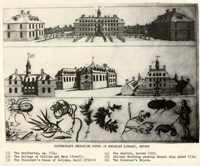 COPPERPLATE ENGRAVING FOUND IN BODLEIAN LIBRARY, OXFORD
COPPERPLATE ENGRAVING FOUND IN BODLEIAN LIBRARY, OXFORD
(1) The Brafferton, ca. 1724;
(2) The College of William and Mary (front);
(3) The President's House of College, built 1732-33
(4) The Capitol, burned 1747;
(5) College Building showing Chapel Wing added 1732;
(6) The Governor's Palace.
5
suggested that originally the two flanking buildings may have been intended as kitchen and stable (the only buildings mentioned in the original act of 1706). It is entirely possible that this was the original plan; and that as the Palace developed further, the stable and coach-house area was enlarged. However, we have found no definite information as to the location of stable and coach-house during the building's existence as residence of the Governors. Nor has archaeological investigation uncovered any evidence that has proved of help in determining their location. A 1781 reference to the state-coach as being "in a building near the Palace," and several nineteenth century insurance policies which show a brick stable in what appears to be the southeast corner of the present Palace grounds (to the east of the present reconstructed "Office"), lend weight to the possibility that the Palace coach-house and stable may have been at that location.1 It would have been a convenient site — and would have balanced the kitchen area (kitchen and associated outbuildings and kitchen-garden) which were to the west of the west flanking building.
To return to the meagre chronology of information concerning the Palace stable, however, inventories and lists of three governors who resided at the Palace indicate that a stable existed which 6 must have housed ten or twelve horses; there was a coach-house which could accommodate four or five coaches, chaises, etc., and possibly a few wagons and carts; and there were quarters for coachman, groom, and considerable equipment; and a fodder house.
Lieutenant-Governor Francis Fauquier, who died at the Palace in 1768, had the following horses, carriages, livestock, etc. at the Palace:
| " 8 horses | [£] 100. _ _ |
| a parcel of Saddles and Cloths | 2. _ _ |
| 12 sheep | 7. _ _ |
| 2 Stalled Beeves | 15. _ _ |
| 17 Head of Cattle | 40. _ _ |
| 9 Hogs | 7.10 |
| 1 Post Chaise and Harness | 25. _ _ |
| 1 Shaft Chair and Ditto | 20. _ _ |
| 1 Coach and Harness for 2 Horses | 40. _ _ |
| 1 Cart and Do for 3 Dotto | 5. _ _ |
| 4 Calves | 3. _ _"1 |
In 1770, Lord Botetourt, who succeeded Fauquier as governor, also died at the Palace in Williamsburg. The inventory of his personal estate indicated that he had even more wheeled vehicles and live-stock on the Premises: 7
"The Out-Houses.
1 State Coach, & Harness for a pair of Horses
1 Post Chaise, with Harness Compleat for four Horses & a Leather Trunk in the Store Room
1 Post Coach with Harness compleat for Six Horses & two draw Boxes (in Store Room)
1 Green park Chair
1 Setter and Grease Box
1 New Waggon & a Cart, with Harness for Six Horses with Leather Collars & Iron Traces
1 Roller, 1 plough, & 1 pair of Harrows, & 1 Bush Frame, and 1 plough paddle
5 Grey Coach Horses, & 1 Mare
2 Grey Saddle Horses, & 1 Mare, & 1 Bay Filly
4 Cows, 1 Bull, 5 Stears, and 3 Calves
2 Barrow pigs, & 1 Boar at the Attorneys
37 Head of Sheep
19 Weathers
1 Stack of Hay
1 Large Wheel Barrow
23 Bushels of Indian Corn
47½ Bushels of Oats
23 Bushels of English Wheat…
1
Coachman's Room & Closet Adjoyning
In Deal Case
6 Horse Sheets, 6 Fillet Cloaths, 3 White Rubbers, 6 Rollers,
4 Saddle Cloaths, 2 Inside Brushes, 6 Horse Brushes, 5 Water Brushes, 3 Oyl Brushes, 1 Hard Brush, 1 Brass Brush,
5 Main Combs & Spunges 2 pr of Stirrup Irons, 2 Spunges,
1 Green Cover for the post Coach
In Post Coach Trunk
8 Horse Nets, Oyl Cloath Cover to Trunk.
In Large Deal Case
2 Oyl Cloath Portmanteau Cases, 2 Horse Muzzles,
17 Rack Reins, 3 Black Stirrup Leathers, 4 Black Straps,
3 Hempen Halters, 4 Currey Combs, 1 Card & Spunge for ye Horses Mains, 2 pr of Hobbles, 1 Girt, 6 Horse Collers new, 6 Do used, 12 Coller Reins, 14½ Sheets Scowring paper, 2 Coach Horse Whips, 1 Phaeton Do (2 Corn Sieves in ye Stable)
1 Field Mahogany Bedstead, 2 Mattrasses, 1 Bolster, 3 Blankets
1 Red and White Flowered Quilt, with Red Check Curtains,
1 Old Oak Table, 1 Walnut Writing Desk, 4 Old Green Bottom Chairs,
1 Swing Looking Glass, 2 Iron Dogs, with Brass Nobs, 1 poker,
1 pr Tongs, 1 Hair Broom, 1 Boot Jack -
Groom's Room & Closet Adjoyning
1 Field Mahogany Bedstead, 2 Mattrasses, 1 Bolster, 3 Blankets,
1 Old Red and White Flowered Quilt, with Red Check Curtains,
2 Old pine Tables, 2 Chamber pots, 1 Close Stool,
3 Silver Stitched new Saddles, with Saddle Cloaths, 1 plain Saddle & Cloath,
1 New Livery Saddle with Furniture, 2 Old Livery Saddles with Furniture, 1 Old plain Saddle, 6 New Snaffle Bridles, 8 2 New pelham Bit Bridles, with polished Bits, 1 New Do with Gold Bosses, and polished Bit, 1 Do almost New with cased Bit, 1 Snaffle Do with cased Bit, 1 Furniture Bridle with Gold Bosses and Blue Badoon, 4 New White Rubbers, 6 Horse Sheets almost New, 3 New Fillet Cloaths, 4 New Saddle pannels, 4 New Rollers, 2 Do a little Worn, 5 New New Horse Nets, 1 New Red Saddle Cloath with white Binding, 1 White Do with Green Binding, 3 Old Furniture Saddle Cloaths, 1 New Breast plate to a Saddle, 3 New Heads & Reins to Furniture Bridles, 7 pr new Stirrup Leathers, 1 Pr Do used, 2 Watering Bridles, 1 New Running Martingale, 5 New Cruppers, 3 Old Do 2 pr New Old Girts, 15 pr New Single Girts, 6 pr New Double Do 3 Surcingles, 3 Old Saddle pannels 2 New Mail pillions and Straps, 2 New Horse Collars, —[torn]Old Horse Collars, 6 New Rack Reins, 6 New Hempen Halters, 1 pr New Stirrup Irons and Leathers, 1 New Crupper, 2 New powder Flasks, 1 pr Holsters almost New, 3 New thin Skins, 1 New Furniture pad, 12 Brass Saddle Buttons and Staples, 1 New Currey Comb, 1 pr of polished Stirrup Irons, 3 pr Silver Mounted Horse pistols, 4 New Horse Joggs, 1 New Furniture Whip 1 Boot Jack (1 Half Bushel, 1 Iron Sieve, 1 Old Cask in Granary)"
Lord Dunmore, the last royal governor to occupy the Governor's Palace, left Williamsburg in 1775. After returning to England, and at the end of the Revolution, he presented a "Schedule of losses" sustained as "His Majesty's late Governor of the Colony of Virginia." His list included the following livestock and vehicles at the Palace in Williamsburg:
| "… | ||
| 16. | In the Park at Williamsburg, 13 Coach and Saddle Horses at - £ 32 | 416. — |
| 17. | - - - A 3 Year old Colt for which £120 has been Offered | 80. — |
| 18. | - - - 3 Valuable Colts at £24 | 72. — |
| 19. | - - - 154 Cattle at 48/ | 369. 12 |
| 20. | - - - 150 Sheep at 8/ | 60. — |
| No 32. | 2 Coaches, one quite new | 160. — |
| 33. | A Chariot | 40. — |
| 34. | A Phaeton, and Two One Horse Chaises | 80. — |
| 35. | Carts, Waggons &c. at the Palace | 40. -"1 |
In 1776, the Governor's Palace was repaired for the use of Patrick Henry, first governor of the Commonwealth of Virginia. Among charges against the Commonwealth for repairs, made by Benjamin Powell, the following items were included:
| "1776 [Nov. 7]... | |
| To putting new shutters & Cross Barrs to Stable Windows | 0: 15: 0 |
| To Repairing Fodder House and Paling Round Garden | 0: 17: 6 |
| 1777. Jany 4. To 60 feet plank 7/6 250 Nails | 3/90: 11: 6 |
| To 4 days of two hands Repairing the Pailing & Railing Round the Pasture | 1: 12: 0"1 |
No further references have been found to stable, coach-house, fodder house, or to horses, vehicles, or equipment having to do with them, until 1781, more than a year after the governor of Virginia had moved to Richmond. In September, 1781, Col. Timothy Pickering, Quartermaster-general with Washington's army during the Yorktown Campaign, described the state coach, which Lord Botetourt had brought to Virginia, as being "in a building near the palace";
"In a building near the palace are to be seen the remains of the richly ornamented state coach, which was brought over with Lord Botetourt, and once used by him to carry him from the palace to the Capitol. `Tis a clumsy machine, and enormously heavy,—perhaps equal to two common wagons. It is gilded in every part, even the edges of the tires of the wheels. The arms of Virginia are painted on every side…"2This is the only eighteenth century reference we have found to the general location of the coach-house.
The main Palace building burned in December, 1781, while serving as a Continental Hospital for sick and wounded soldiers. The flanking buildings and outbuildings survived; and in 1784, the Palace lands were vested in the College of William and Mary by the 10 State of Virginia.1 The Palace Lands and the remaining buildings thereon were advertised for sale at public auction, to be held at the Raleigh Tavern on June 15, 1785.2 Edmund Randolph purchased the lands, and between the years 1786 and 1789, Humphrey Harwood, a local builder, made repairs to the flanking buildings and some surviving outbuildings, for Randolph. Unfortunately, no reference to the stable or coach-house appears in the accounts of repairs. The flanking buildings survived until the period of the War Between the States, being used as dwellings by a series of occupants who followed Randolph's ownership.
In 1837, both flanking buildings were owned by Samuel F. Bright, who insured them, and several outbuildings, with the Mutual Assurance Society of Virginia.3 Policy No. 8610 (see photostat attached) indicated the kitchen to the west of the west flanking building; and "F. Stable of Brick covered with wood 36 by 32," valued at $600., to the east of the east flanking building, in what appears to be the southeastern corner of the original Palace grounds. This may have been a part of the Palace stable and coach-house. In 1838, Bright insured the east flanking building in a separate policy (No. 10,761 - see photostats attached), at which time it was occupied by Richard Randolph. An addition had been made to the east flanking building, and the policy also showed a smoke house, and the "Brick stable covered with wood one story 34 by 40," still valued at $600.. Whether 11 the stable had been enlarged, or whether the dimensions in the first policy were carelessly given, we do not know, The brick stable was noted in subsequent policies as follows, although no dimensions were given: No. 14,400 - when the east flanking building was insured in 1846 by Charles Minnegerode — stable valued at $500.; No. 17,649, when the buildings were insured in 1853 by James and Letitia Tyler Semple — stable valued at $500.; and No. 21,343, when in 1860 the buildings were insured by the trustees for Mrs. L. T. Semple as then occupied by Mr. Douglas - brick stable valued at $300..
Several pictures exist of the east and west flanking buildings during these years. Unfortunately, there are no pictures of the stable, and the only other reference we have found to it appears in Mr. John S. Charles' recollections of Williamsburg, ca. 1861, in which he mentioned "a big brick barn and stable" as follows:
"…Part of the bricks used in the construction of this school house, [the Matty School which stood near the site of the main Palace building] were taken from an old wall which extended across the north end of the plot of land just west of the school house. The writer knows whereof he writes as to this, as he assisted in removing and cleaning these colonial bricks, which now constitute part of the walls of the aforementioned school house… There were no other houses in this lot except there was to the east of the Palace lot, on Scotland Street, a big brick barn and stable; evidently once being a part of the palace equipment. This disappeared years ago. The gate to the Palace farm, as the land to the northward was called, was at the eastern side of this big brick barn. On this farm were remnants of what had once been an oil factory. Castor Beans were once raised on this place…"1
Report by: M. Goodwin
March, 1955
Footnotes
Mrs [illegible]
Here are those [illegible] stables from the [illegible] & the city & [illegible] — I have identified one of each (there are 3 photostats & each of the three photographs.) I have the negative photostats if you should want other prints
T[illegible]
July 7
 Race Horses in a Stable
Race Horses in a Stable
oil painting by James Seymour, 1747
reproduced in THE TURF by John Hislop. Collins, London MCMXLVIII
op. p. 9, by courtesy of Messrs. Fores
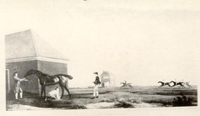 Gimcrack Being Rubbed Down
Gimcrack Being Rubbed Down
oil painting by George Stubbs, c. 1763
reproduced in THE TURF by John Hislop. Collins, London MCMXLVIII op. p. 8. by courtesy of the Stewards of the Jockey Club, Newmarket
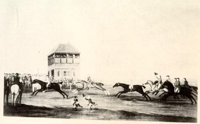 A Race over the Beacon Course, Newmarket
A Race over the Beacon Course, Newmarket
oil painting by John Nost Sartorius, 1787
reproduced in THE TURF by John Hislop. Collins, London MCMXLVIII op. p. 16, by courtesy of Messrs. Fores
PALACE STABLE
House naming committee on Nov. 4 1958 decided upon following names for the stable group to be reconstructed:
- 1Palace Stable
- 2Coach house
- 3New coach house
See memo to files in Naming committee folder.
